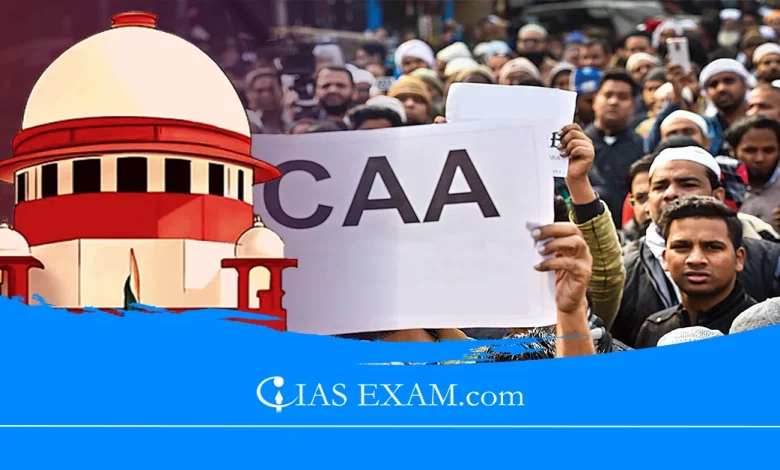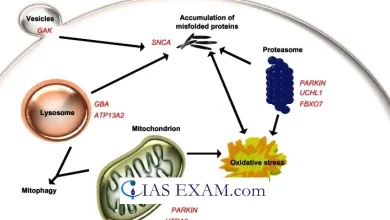Daily Current Affairs for UPSC
Citizenship Amendment Rules under the Citizenship Amendment Act (CAA)
Syllabus - Government Policies and Interventions [GS Paper-2]

Context
The Ministry of Home Affairs has recently notified the Citizenship Amendment Rules under the Citizenship Amendment Act (CAA),2019.
Background
- In December 2019, Parliament passed an amendment to The Citizenship Act, 1955, to encompass a provision for grant of citizenship to migrants belonging to the Hindu, Sikh, Buddhist, Jain, Parsi, or Christian groups who entered India before December 31, 2014 from Pakistan, Afghanistan, or Bangladesh.
- The regulation was notified on January 10, 2020 amidst protests around the country, specifically in Assam, but couldn’t be implemented in the absence of the Rules.
- On May 28, 2021, the Union government issued an order under Section 16 of the Citizenship Act, 1955, giving district collectors in 13 districts with excessive migrant populations the power to accept citizenship applications from groups identified in the 2019 amendment.
Citizenship Amendment Act (CAA), 2019
- It seeks to fast-track Indian citizenship to Hindus, Sikhs, Buddhists, Jains, Parsis and Christians – except for Muslims – who migrated to India owing to non religious persecution in Pakistan, Afghanistan and Bangladesh.
- In essence, the 2019 amendment relaxed the eligibility criteria for certain classes of migrants (on non religious lines) from three neighbouring Muslim-majority countries.
- Exemption: Certain categories of regions, consisting of tribal areas in Assam, Meghalaya, Mizoram, and Tripura, and regions included by the ‘Inner Line’ system, had been exempted from the purview of the CAA.
- The idea of Inner Line separates the tribal-majority hills of the Northeast from the plains regions. To enter and stay in these regions, an Inner Line Permit (ILP) is needed.
Highlights of the Citizenship (Amendment) Rules, 2024
- Eligibility: Who can apply for Citizenship
-
-
- An individual of Indian origin seeking registration as a citizen of India
- An individual married to a citizen of India, seeking registration as a citizen of India
- An application from a minor toddler of an Indian citizen, seeking registration as a citizen of India, and many others.
-
- Document to be attached for Citizenship by naturalization
-
-
- Form VIIIA Submission: The applicant submits Form VIIIA, which incorporates all vital personal details and records required for the naturalization process.
- Affidavit Verification: The applicant should provide a testimony verifying the accuracy of the statements made in the application.
- Character Affidavit: Additionally, the applicant ought to furnish an affidavit from an Indian citizen attesting to the applicant’s individual. This affidavit acts as a testament to the applicant’s reputation and behavior.
- Language Declaration: The applicant is required to claim that they possess adequate knowledge of one of the languages distinct in the Eighth Schedule to the Constitution of India.
-
- Process for application submission
-
- Submission of Application: Applications are to be submitted electronically by the applicant to the Empowered Committee through the District Level Committee designated by the Central Government.
- Acknowledgment: Upon submission, an acknowledgment in Form IX is electronically generated.
- Document Verification: The District Level Committee, led by a Designated Officer, verifies the documents submitted along with the application.
- Oath of Allegiance: The Designated Officer administers the oath of allegiance designated inside the Second Schedule to the Citizenship Act, 1955, to the applicant.
- Renunciation Declaration: Every application includes a declaration by the applicant renouncing their citizenship of their current country, irrevocably and without future claim.
Issues/Challenges
- The legal challenge: The 2019 change was challenged before the Supreme Court in 2020 by the Indian Union Muslim League (IUML) and others, on the grounds of discrimination.
- The right to equality: The challenge to the CAA rests on the floor that it violates Article 14 of the Constitution, which says that “the State shall no longer deny to any person equality before the regulation or the equal protection of the legal guidelines within the territory of India”.
- The petitioners’ argue that using religion as a qualifier or a filter violates the essential right to equality.
- Targeted towards Muslims: The petitioners have argued that the National Register of Citizens (NRC) in Assam to identify unlawful immigrants, alongside the CAA, will result in the targeting of Muslims.
- Secularism: There is likewise the larger issue of whether or not making religion a floor for eligibility for citizenship violates Secularism, which is a basic characteristic of the Constitution.
- Section 6A of The Citizenship Act, 1955 and Assam: Section 6A was introduced in the Citizenship Act after the signing of the Assam Accord in 1985 which determines who’s a foreigner within the nation of Assam and sets March 24, 1971 as a cut off date which contradicts the reduce off date given in the CAA 2019.
- Widespread protests: The protest in Assam and different northeastern states turned violent over fears that the move will cause a loss of their “political rights, way of life and land rights” and motivate further migration from Bangladesh.
Government’s stand
- The government has stated that Muslims had been excluded from the institution of “persecuted” minorities because Pakistan, Afghanistan, and Bangladesh are Islamic countries in which Muslims are in majority.
- However, it’ll be tested whether these three countries were picked essentially to keep Muslims out — this is because groups like Tamil Hindus in Sri Lanka, the Rohingya in Myanmar, or minority Muslim sects like Ahmadiyyas and Hazaras are also persecuted minorities in these countries.
What lies beforehand?
- The court will should investigate issues:
-
- Whether the special treatment given to the so-referred to as “persecuted minorities” from the three Muslim-majority neighbouring countries only is an inexpensive class under Article 14 for granting citizenship, and
- Whether the nation is discriminating in opposition to Muslims by except for them.
- The Supreme Court has earlier held that the regulation has to clear two legal hoops to bypass the equality test while it’s far challenged at the grounds of Article 14.
- First, any differentiation between groups of persons have to be founded on an “intelligible differentia”, and
- Second, “that differentia needs to have a rational nexus to the object sought to be achieved by the Act”.
- The SC can strike down a classification if it’s far determined to be arbitrary. The court recently struck down the electoral bonds scheme on the grounds that it was “manifestly arbitrary” — this is, “irrational, capricious or without an adequate determining principle”.
Source: The Indian Express
UPSC Mains Practice Question
Q.In light of Citizenship (Amendment) Rules, 2024, mention the changes in the condition for Acquisition of Citizenship in India. Is said amendment against the secular fabric of India?





.png)



